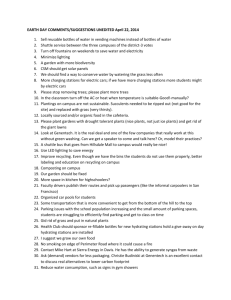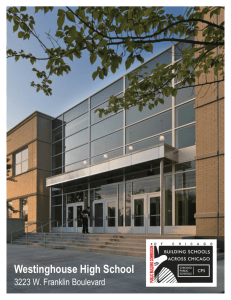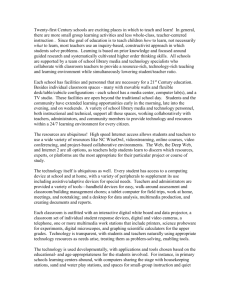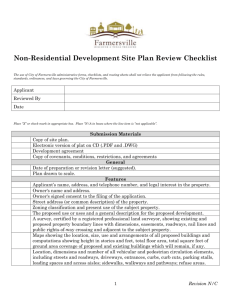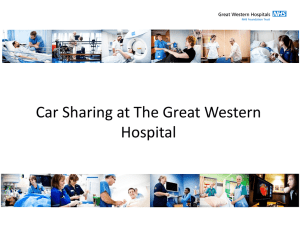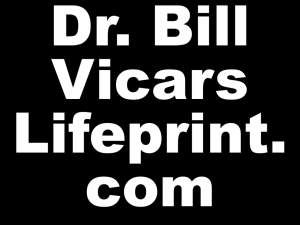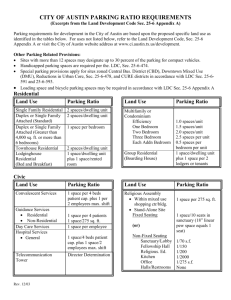Putting The City In Motion
advertisement
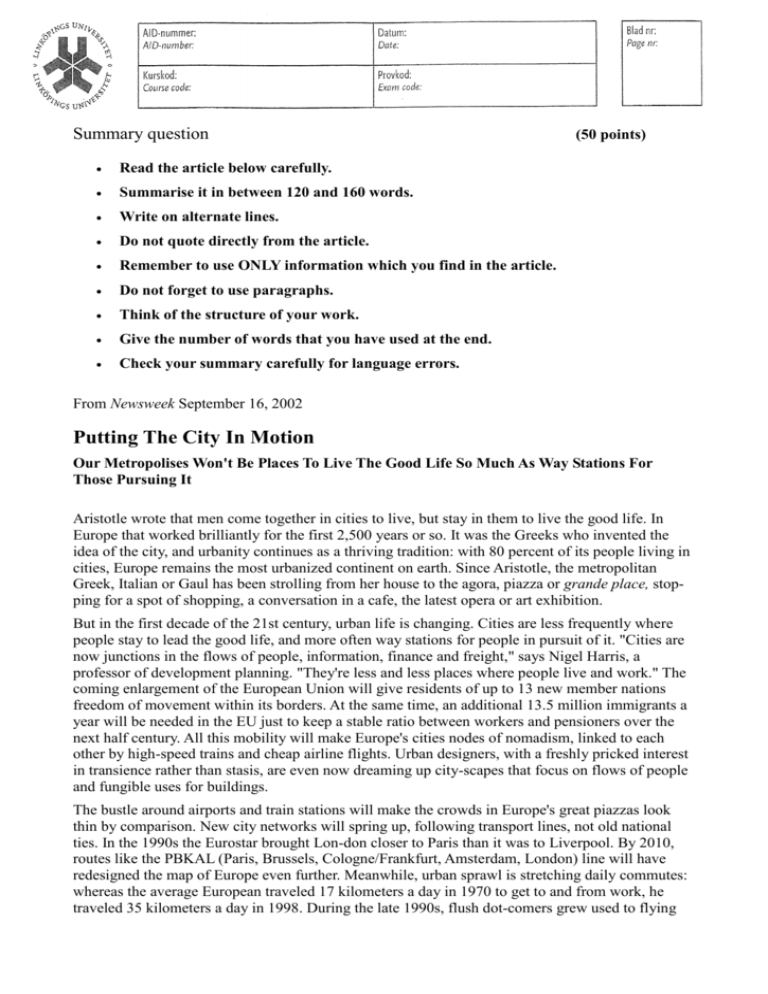
Summary question Read the article below carefully. Summarise it in between 120 and 160 words. Write on alternate lines. Do not quote directly from the article. Remember to use ONLY information which you find in the article. Do not forget to use paragraphs. Think of the structure of your work. Give the number of words that you have used at the end. Check your summary carefully for language errors. (50 points) From Newsweek September 16, 2002 Putting The City In Motion Our Metropolises Won't Be Places To Live The Good Life So Much As Way Stations For Those Pursuing It Aristotle wrote that men come together in cities to live, but stay in them to live the good life. In Europe that worked brilliantly for the first 2,500 years or so. It was the Greeks who invented the idea of the city, and urbanity continues as a thriving tradition: with 80 percent of its people living in cities, Europe remains the most urbanized continent on earth. Since Aristotle, the metropolitan Greek, Italian or Gaul has been strolling from her house to the agora, piazza or grande place, stopping for a spot of shopping, a conversation in a cafe, the latest opera or art exhibition. But in the first decade of the 21st century, urban life is changing. Cities are less frequently where people stay to lead the good life, and more often way stations for people in pursuit of it. "Cities are now junctions in the flows of people, information, finance and freight," says Nigel Harris, a professor of development planning. "They're less and less places where people live and work." The coming enlargement of the European Union will give residents of up to 13 new member nations freedom of movement within its borders. At the same time, an additional 13.5 million immigrants a year will be needed in the EU just to keep a stable ratio between workers and pensioners over the next half century. All this mobility will make Europe's cities nodes of nomadism, linked to each other by high-speed trains and cheap airline flights. Urban designers, with a freshly pricked interest in transience rather than stasis, are even now dreaming up city-scapes that focus on flows of people and fungible uses for buildings. The bustle around airports and train stations will make the crowds in Europe's great piazzas look thin by comparison. New city networks will spring up, following transport lines, not old national ties. In the 1990s the Eurostar brought Lon-don closer to Paris than it was to Liverpool. By 2010, routes like the PBKAL (Paris, Brussels, Cologne/Frankfurt, Amsterdam, London) line will have redesigned the map of Europe even further. Meanwhile, urban sprawl is stretching daily commutes: whereas the average European traveled 17 kilometers a day in 1970 to get to and from work, he traveled 35 kilometers a day in 1998. During the late 1990s, flush dot-comers grew used to flying from London to Paris for the day. If trade-liberalization trends continue, it won't just be global elites who country-hop for work. In a phenomenon Harris has called "extreme commuting," cities like London could be flying in planeloads of, say, Moroccans or Turks in weekly rotations to clean streets or hospitals. In the 20th century, business travelers often avoided the hotel near the railway station, so often associated with grimy red-light districts and cheap pensions. But with so much traveling going on, railway stations and airports will become strong civic hubs, attracting shops, offices and restaurants. Notes Harris: "Once you've got an international transportation terminal, these city areas become international centers, with all kinds of activities, most often based on knowledge industries." Other public spaces are due for a revamp as well. Earlier architects conceived of train stations as single buildings; today's designers are thinking of them as transit zones that link to the city around them, pouring travelers into bus stations and surrounding shops. In Amsterdam, urban planner Ben van Berkel, codirector of the design firm UN Studio, has developed what he calls Deep Planning Strategy, which inverts the traditional "top down" approach: the creation of a space comes before the flow of people through it. With 3-D modeling and animation, he's able to look at how different population groups use public spaces at different times of the day. He uses the data to design spaces that accommodate mobs at rush hour and sparser crowds at other times. "A city is like a waterbed," says van Berkel. "If you put pressure on one part, it will affect other parts. You can't just build something in isolation." The growing mobility of Europe has inspired a debate about the look and feel of urban sprawl. "Up until now, all our cultural heritage has been concentrated in the city center," notes Prof. Heinrich Mding of the German Institute of Urban Affairs. "But we've got to imagine how it's possible to have joyful vibrancy in these [outlying] parts, so that they're not just about garages, highways and gasoline tanks." The designs for new buildings are also changing to anticipate the emerging city as a way station. "Architecture has classically been fixed," says Alejandro Zaera Polo of the Londonbased firm Foreign Office Architects, who with his partner, Farshid Moussavi, is representing Britain at the Venice Architecture Biennale this month. "Buildings have been seen as disconnecting, isolating, defining. But increasingly, the quality of space that's in demand is movement." In the Japanese city of Yokohama, for example, Foreign Office created a port terminal that incorporates the idea of mobility into the structure itself. Partitions for the space move on wheels, and there are no stairs: passengers move around on ramps. In the Dutch city of Groningen the firm created the Blue Moon aparthotel. Among the building's "skins": a "duvet facade," allowing the inhabitants to zip or unzip the cloth walls, creating rooms and windows of varying sizes, depending on whether they're using the space to sleep or for business meetings. Foreign Office is building a sports park in Barcelona that takes the notion of flexibility even further. The park will have stadiums embedded in the landscape, near playing fields, with roofs that can roll back to open the stadiums for concerts or games. In the industrial era, cities needed to have access to raw materials to thrive. Now the trend is reversing: to attract people with the brains or capital to produce economic growth, a city has to lure them with its lifestyle and culture. In a globalized economy, spectacular parks, museums or stadiums are becoming ever more important. "In the old days, 'hard' locational factors, like whether you had a harbor or a traffic crossroads, determined whether you'd succeed as a city," says Mding. "These days, attractions of the natural and cultural environment are going to determine where firms are located." Cities may have changed since Aristotle's time. The quest for the good life hasn't. Cars in Cities Ever wondered what the car industry will do when roads become so congested there is no longer enough room to squeeze in any more cars? That is what is starting to happen in Japan, where car makers are moving into the car-parking business and building special driving courses where motorists can go to escape the country’s traffic jams. The impetus has come from tough new parking rules, backed up by hefty fines that came into force this summer. In order to register a car in Japan, the owner must have somewhere to park it. The new rules require a sticker to be displayed to prove the owner has a parking space at home or near the office. But parking a car in Japan is expensive. Spaces in some residential areas in Tokyo can cost as much as $1,7000 a month. To help persuade households to buy a second car, some of Japan’s car makers have moved into the business of selling machines which make double-tier parking possible. These allow two cars to share the same parking space. They work like a lift. The driver parks his first car on a platform, then flicks a switch which raises the platform to allow a second car to be parked underneath. Toyota now sells six such devices, costing a great deal. Honda not only sells home-parking equipment, but also manages car parks and provides information on the availability of parking spaces for car buyers. Nissan even offers a home-parking machine that lowers cars into a pit below ground. Nissan has also opened a mobility park 140 kilometres outside Tokyo. This provides buyers of four-wheel-drive vehicles somewhere to get their tires dirty. The park provides instructors and a variety of off-road courses, ranging from a beginner’s trail to an advanced course for more experienced off-roaders. For less experienced drivers, an ambulance is on standby. Letter (50 points) After having read the above article, speak as a pedestrian or cyclist, and say what changes you would like to see to traffic management in your city or town? Write a letter (using the appropriate formal letter structure) to a local municipality giving suggestions for improvements in a particular area in Sweden. You must state the problems and then offer some suggestions. You must create an address for the municipality and remember to write in formal language. The body of your letter should be between 120 and 150 words. Write the number of words at the end of the letter. Use separate paper for this task. Editing 10 points The following text has 21 errors of language. Punctuation is not a problem. Find the errors, underline them and correct them in the space below. (DO NOT USE A SEPARATE PIECE OF PAPER FOR THIS TASK!) The first one has been done for you as an example. Can London’s skyline grow up gracefully? Coherence, not competision, is the key, says Hugh Pearman. The sunday times magazine said competition last year that London was taking over from New York as the worlds financial centre. Glance at the skyline off cranes and girders, and your inclined to agree. And if theirs one thing a preeminent financial centre love its talk of new skyscrapers. As the economical graph goes zinging upwards, so do the plans of ambitious developers and their ever-eager architechts. Nobody can ignore a skyscraper. Which is why a public inquiry is taking place into designs for one that look like a giant walkie-talkie. We Brits isn’t natural tower-erectors, we built them with bad grace. Untill Norman Foster produced the lovable 590ft “Gherkin” in the hard of London, we was bumping along in a wake of the americans. They new how to build tall, from the Empire State building to the Chrysler building built in the 1930:s. We Brits first ___________________________________________________________________________ got our first true skyscraper at the end of 1979. Vocabulary (25 points total) Part 1 (10 points) Underline the correct word for each of the following sentences. 1. Being (conscientious/conscious), highly professional fashion (correspondence/correspondents), means that we must even pay attention to what we wear in bed! 2. One consequence of the urban sprawl is a marked increase in (communing/commuting) distances for suburban inhabitants. 3. Here are six tips to reduce the risk of injury and (ensure/insure) your child doesn't end up in hospital. 4. A wealth of (advise/advice) and guidance will be on hand the unemployment agency. 5. Please wait here and the headmaster will be out to see you (briefly/shortly). 6. The (work/job) is very interesting, but the (income/salary) isn't all that much. 7. I was so shocked at the news that I didn't know (whether/weather) to laugh or cry. 8. The white foreground has the effect of making light seem to (emanate/emit) from within the picture. 9. The company forced to downsize for (economical/economic) reasons. 10. An inquiry is underway into an (illicit/elicit) party at a top-security jail. 11. Once I had paid for my prescription, the Chemist gave me my (recipe/receipt). 12. When the old Earl died, the estate was divided equally (among/between) his two sons. 13. My colleague (insured/assured) me that he would (raise/rise) the matter at the next meeting. 14. We hope that we (choose/chose) the right person to be a member of the (counsel/ council). 15. I hope that you will (bare/bear) with us as we reorganize our office space. 16. The walls were well (isolated/insulated) in the house, so the winters were quite tolerable. Explain in English the words underlined. Write explanations not synonyms. 10 points 17. New Jersey has just abolished the use of capital punishment. _____________________________________________________________ 18. By one reckoning, the average person can be caught on film 300 times in Newham. _____________________________________________________________ 19. For politicians, cameras are a rather cost-effective solution to crime. _____________________________________________________________ 20. Manu Moto is particularly scathing of the Lustucru. ______________________________________________________________ 21. The rehabilitation projects were spearheaded by individual districts. ______________________________________________________________ 22. Crime has not been eliminated rather dispersed. _______________________________________________________________ 23. Many people like to dabble in art, but how many can say they are really good at it? ________________________________________________________________ 24. Jean Cocteau was rather a prolific creator. ________________________________________________________________ 25. Theater is flourishing in the center of London. ________________________________________________________________ 26. The hyperbole surrounding the issue of climate change is quite tiring at times. _________________________________________________________________ Choose the most suitable alternative from the alternatives given. 5 points 27. Attendance is often …….. in many university classes. a) assisted b)desired c) obligatory d) attired 28. Having your passport when traveling will…….matters at the airport. a) leave b) produce c)elicit d) facilitate 29. A parent must obtain …….. to be off from work a) validity b) ensurance c) leave d) deportation 30. ……………………….. in any major city is expensive. a) accomodation b) accommodation c) acommodation 31. You must check-in ……………….. boarding. a) prior b) prior to c) previous d) accomadation d) previous to 32. Do not hesitate to contact our representative if you ………………… further information. a) want b) wish c) desire d) request 33. The tour is 10 days …………..and commences on Saturday 11 June. a) of duration b)in existence c) of duration d) of departure 34. Special rates are available for periods ……. of three months. a) of access b) in excess c) of excess d) in access 35. Drivers must have ……. a valid licence for at least three years. a) produced b) held c) endured d) desired 36.The driver must return the car on the exact …….date. a) terminating b) commencing c) priority d) terminal
